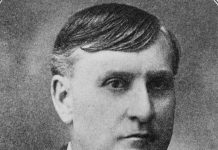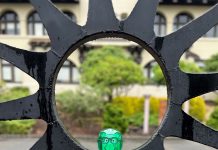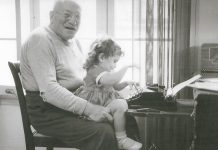In the sports world, the mascot is a time-honored institution. It’s the job of a common man or woman, dressed as a large moose, bratwurst or even geoduck, attempting to dance and selfie their way into the hearts and social media feeds of their team’s fans and players. They hope to conjure up team spirit and a winning outcome.
Why does someone subject themselves to being entombed inside a sweaty, cartoonish costume for hours at a time? Is it a love of the game? Adoration for the fans? The masochistic enjoyment of turning your body into a sieve for perspiration? I wanted to know.
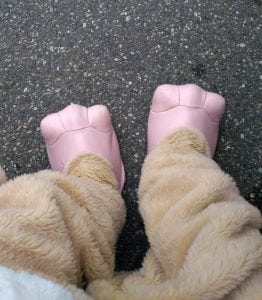
So, in summer 2018, I began moonlighting as the back-up mascot person for the Bellingham Bells baseball team. Their mascot, Dinger the “Bellinghamster,” is an adorably fuzzy and rotund hamster in his eleventh year of cheering on this collegiate summer league team. In 2022, I assumed full-time Dinger duty.
What’s it like being Dinger? Let me tell you.
The Costume
Becoming a giant, baseball-loving hamster begins with the body suit — a warm, furry uniform featuring multiple hula-hoops attached in the middle to create Dinger’s portly visage. The suit is put on from the front, arms-first like a strait jacket, and zips up from the back. Next comes Dinger’s custom jersey, emblazoned with the number “04,” designating 1904, the year Bellingham was incorporated as a city.
The hamster feet come next. They’re big and hollow inside and tighten around my ankles with Velcro strips. Despite this, the feet can feel loose and spacious, like they’re about to fall off. The only way to fix this is by stuffing sandals or running shoes into the feet, creating a more stable feeling while waddling around.
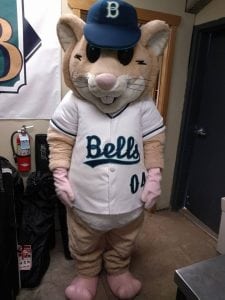
After that come the bright pink gloves. While Dinger always accepts high-fives, he can only give high-fours, having just a thumb, pinkie, index finger and large middle digit that would confound most jewelry fitters.
Finally, there’s the headpiece: the part of the costume that truly transforms me from man to anthropomorphic hamster. The head is made wearable by a skateboard helmet fitted inside, with a chinstrap to keep someone’s childhood from being irreversibly scarred, should I somehow fall to the ground. Unlike many mascot costumes, I look directly through Dinger’s eyes to see. That, however, doesn’t mean my vision is unrestricted.
Inside the hamster head, I have no peripheral vision. The only way to see my feet is to look out Dinger’s mouth, past his one large bucktooth. These blind spots are just enough for me to haplessly walk into anything at waist-level or worse, leave a high-five-seeking child hanging in an unintentional display of rudeness.
The Routine
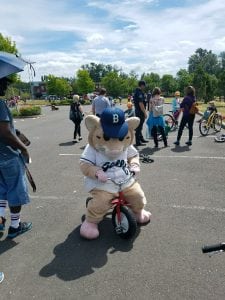
Being a backup hamster means I cover any games the main Dinger performer can’t make, plus a handful of community events held outside the ballpark. For outside gigs, I’ll meet a Dinger “handler” in a parking lot near the event. It sometimes feels like a drug deal, except instead of seeing drugs when they open their car trunk, there’s a hamster costume.
For baseball games, it’s more straightforward: I show up an hour before first pitch, climb into the costume and help greet fans at the gate. In the games I’ve worked this season, I’ve high-foured and hugged countless children, visibly frightened several more, posed for dozens of photos and danced to “What is Love” as it blared over the PA system.
Once the game starts, Dinger participates in a few on-the-field contests during the middle of innings. My favorite is the “Beat the Heat” sprint, where a Bells employee dresses in tight, red spandex and, as a physical manifestation of heat, tries to outrun a child sprinting towards my open palm.
Dinger’s most important moment is the Dinger Run, held in the middle of the fifth inning. Basically, I hold excited children at bay behind a gate near first base. Once it opens, a pediatric Running of the Bulls commences, as dozens of children run around me, along the grassy edge of the infield, to another gate past third base. It feels kind of like that scene in Jurassic Park, where Dr. Grant and the children are running both from and with dinosaurs.
The second time I did the run, I carried a flaming torch across the field as part of the Peace Run, my worry split between accidentally crushing a child and setting myself on fire. Fortunately, neither thing happened.
Dinger’s duties conclude in the eighth inning, leading the grandstand in a rendition of “Sweet Caroline.” Because I can’t talk when I’m in costume, I focus on arm movement and dancing. The first time I did this, a child slapped my butt.
The Sweat
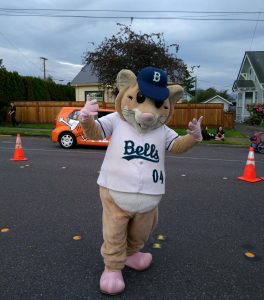
Being Dinger is a stamina challenge, testing hydration standards, antiperspirants and the ability to function happily despite being saturated with your own sweat. After more than a few minutes inside the costume, it’s like being in a sauna. You perspire freely, from everywhere. Moisture-wicking clothes are essential and even then, you will still feel sticky.
After an hour without a break, my hair is so covered with sweat it looks like I’ve just climbed from the shower. Occasionally, and usually at an inconvenient moment, a bead of sweat will run down into one of my eyes, creating a lovely burning sensation. All the while, I must still dance. I must still pump my fists and I must still hold a woman’s baby — and not drop it — while she takes a photo. Nobody said this job was easy.
Frequent breaks are taken, inside what is essentially a large storage closet. Gatorades go down fast and easy. It’s critical to make sure the door is closed when you remove the head, to avoid ruining a child’s perception. Besides breaks, there’s only one other way to keep cool: the ice vest. It has a mesh compartment filled with plastic ice cubes and wearing it creates a welcome sense of relief for an inning or two. But once the condensation wears off, you tend to just feel even wetter.
The Reward
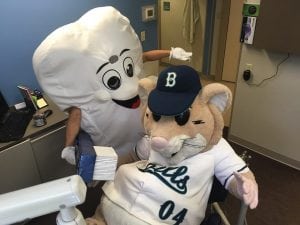
So why do I do it? It’s really quite simple. During my time as Dinger, I’ve been put into often-surreal situations from which I’ve derived immense joy:
- Walking through an active dental clinic and surprising dentists, some of whom were in the middle of teeth cleanings
- Hovering over the buffet at a Mexican restaurant while people broke out cameras as if I were famous
- Trying to ride a tricycle at a children’s safety fair
- Upsetting numerous dogs that see Dinger as an alien threat to be defended against
- Strolling down Cornwall Avenue while a middle school marching band plays “All-Star” by Smash Mouth right behind me
- Signing a child’s baseball
- Having an eight-year-old boy rap several verses of Eminem’s “Lose Yourself” to me before stopping and telling me he couldn’t remember any more of the song.
There are too many others to mention. Being Dinger is a license to be playful and silly, and to do so anonymously. There is something almost addicting about it, of feeling goofy and realizing you don’t feel the least bit embarrassed because nobody sees you; they just see Dinger.
Doing this is not about making a few extra bucks during the summer. It’s about being part of the community and about realizing that this silly costume brings true joy to a lot of children and, in many cases, adults too.
And that, more than anything else, is worth my time and sweat.






